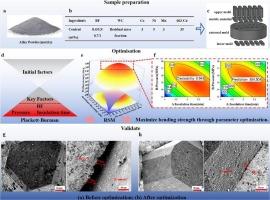用响应面法优化玄武岩纤维增强浸渍金刚石钻头基复合材料热压烧结参数
IF 4.6
2区 材料科学
Q2 MATERIALS SCIENCE, MULTIDISCIPLINARY
International Journal of Refractory Metals & Hard Materials
Pub Date : 2025-08-06
DOI:10.1016/j.ijrmhm.2025.107365
引用次数: 0
摘要
为了提高热压烧结金刚石钻头基体的抗折强度,将烧结试样的抗折强度作为响应变量。考察了保温时间、保压时间、温度、压力、玄武岩纤维(BF)含量、金刚石浓度等因素对保温效果的影响。使用Plackett-Burman设计筛选影响抗弯强度的重要因素。采用最陡上升法和Box-Behnken响应面法对热压烧结工艺进行了优化,对32组轮胎块体试样进行了烧结。结果表明,保温时间和BF含量是影响抗弯强度的重要因素。通过响应面优化,确定了最佳热压烧结参数为:保温时间5 min,保压时间5 min,温度960℃,压力15 MPa,金刚石浓度20 vol%, BF含量0.586 %。在此条件下,试样的抗弯强度达到377.8 MPa,实验值与预测值基本吻合。实验结果为优化热压烧结参数提供了理论指导和技术支持。本文章由计算机程序翻译,如有差异,请以英文原文为准。

Optimization of hot press sintering parameters for basalt fiber reinforced impregnated-diamond drill bit matrix composite materials using response surface method
To improve the bending strength of diamond drill bit matrix prepared by hot-press sintering, the bending strength of the sintered samples was used as the response variable. The effects of factors such as insulation time, pressure holding time, temperature, pressure, basalt fiber (BF) content, and diamond concentration were investigated. Significant factors affecting bending strength were screened using a Plackett-Burman design. The steepest ascent method and Box-Behnken response surface methodology were employed to optimize the hot-press sintering process, 32 sets of tire block samples were sintered. The results showed that insulation time and BF content were significant factors influencing the bending strength. After response surface optimization, the optimal hot-press sintering parameters were determined as follows: insulation time of 5 min, pressure holding time of 5 min, temperature of 960 °C, pressure of 15 MPa, diamond concentration of 20 vol%, and BF content of 0.586 %. Under these conditions, the bending strength of the samples reached 377.8 MPa, with experimental values closely matching the predicted values. The experimental results provide theoretical guidance and technical support for optimizing the hot-press sintering parameters.
求助全文
通过发布文献求助,成功后即可免费获取论文全文。
去求助
来源期刊
CiteScore
7.00
自引率
13.90%
发文量
236
审稿时长
35 days
期刊介绍:
The International Journal of Refractory Metals and Hard Materials (IJRMHM) publishes original research articles concerned with all aspects of refractory metals and hard materials. Refractory metals are defined as metals with melting points higher than 1800 °C. These are tungsten, molybdenum, chromium, tantalum, niobium, hafnium, and rhenium, as well as many compounds and alloys based thereupon. Hard materials that are included in the scope of this journal are defined as materials with hardness values higher than 1000 kg/mm2, primarily intended for applications as manufacturing tools or wear resistant components in mechanical systems. Thus they encompass carbides, nitrides and borides of metals, and related compounds. A special focus of this journal is put on the family of hardmetals, which is also known as cemented tungsten carbide, and cermets which are based on titanium carbide and carbonitrides with or without a metal binder. Ceramics and superhard materials including diamond and cubic boron nitride may also be accepted provided the subject material is presented as hard materials as defined above.

 求助内容:
求助内容: 应助结果提醒方式:
应助结果提醒方式:


